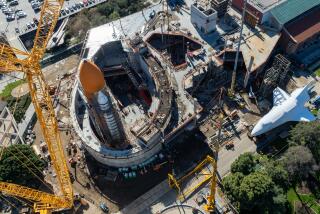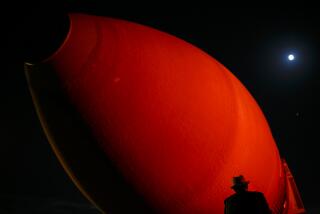Shuttle to Lift Off Today With Gamma Ray Satellite : Space: Atlantis to orbit observatory to probe universe’s most violent events. The mission will include a spacewalk.
- Share via
KENNEDY SPACE CENTER, Fla. — The space shuttle Atlantis was set to blast off today to deliver into space a huge observatory that will probe some of the most violent events in the universe.
Weather forecasters gave the National Aeronautics and Space Administration up to an 80% chance of launching the Atlantis during an unusually long window of four hours and seven minutes that opens at 6:18 a.m. PST.
The Gamma Ray Observatory, which will study gamma rays emitted by some of the most mysterious objects in the sky, is to be deployed on the third day of the mission. The 35,000-pound satellite, the second in NASA’s planned series of four orbiting observatories, is the heaviest civilian payload that the shuttle has ever launched.
On the fourth day of the mission, crew members Jerry L. Ross, 43, and Jay Apt, 41, are scheduled to make the first U.S. spacewalk in more than five years. The purpose of the six-hour excursion will be to practice techniques that will be needed for astronauts to assemble the Space Station Freedom in orbit.
The shuttle is to land Wednesday morning at Edwards Air Force Base in Southern California, assuming that the launching is on time.
The Gamma Ray Observatory, built by TRW Inc. of Redondo Beach as part of a $617-million program, including $60 million in European instruments, will move NASA scientists a giant step closer to their dream of studying the universe at all wavelengths of the electromagnetic spectrum.
Only a small part of the spectrum is visible light, and humans see the universe only in that wavelength. Yet many events, such as exploding stars, emit energy at wavelengths that the human eye cannot see, and the study of that light can tell scientists much about the processes that created it.
Gamma rays are emitted primarily when matter is compressed or heated to the point that it is transformed into nearly pure energy through a nuclear reaction. That occurs in such events as stellar collisions, exploding stars and material being ripped apart in the violent region surrounding a black hole, an object so dense that even light cannot escape.
“Only the most violent processes make gamma rays,” said Charles Pellerin, director of the astrophysics division at NASA headquarters in Washington, D.C.
Because the Earth’s atmosphere interferes with gamma rays, research at that wavelength can best be done from space. The observatory will, for the first time, permit scientists to search the entire sky for gamma ray sources.
Scientists expect the results to change their thinking about many celestial objects, and they expect a few surprises.
“I’m completely confident we are going to see things we don’t know anything about,” said NASA scientist Lennard Fisk.
This is NASA’s first flight of the year. Air Force Col. Steven R. Nagel, 44, flight commander, will be making his third space flight. Marine Corps Lt. Col. Kenneth D. Cameron, 41, the Atlantis’ pilot, is making his first space flight.
The fifth member of the crew is Linda M. Godwin, 38, a physicist.






